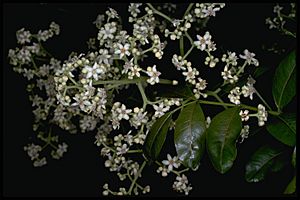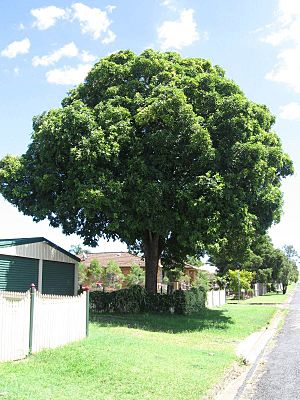Crow's ash facts for kids
Quick facts for kids Crow's ash |
|
|---|---|
 |
|
| Scientific classification | |
| Genus: |
Flindersia
|
| Species: |
australis
|
Flindersia australis, commonly known as crow's ash, flindosy or Australian teak, is a species of tree that is endemic to north-eastern Australia. It has pinnate leaves with between five and thirteen egg-shaped to elliptical leaflets, white to cream-coloured flowers arranged in panicles on the ends of branchlets and followed by woody capsules studded with short, rough points and containing winged seeds.
Description
Flindersia australis is a tree that typically grows to a height of 40 m (130 ft), larger trees usually having a buttressed trunk. The leaves are usually arranged alternately and are crowded near the ends of the branchlets. The leaves usually have between five and nine elliptical to egg-shaped leaflets that are 24–130 mm (0.94–5.12 in) long and 8–43 mm (0.31–1.69 in) wide, the side leaflets on a petiolule up to 3 mm (0.12 in) long and the end leaflet on a petiolule sessile or on a petiolule up to 32 mm (1.3 in) long. The flowers are arranged in panicles 50–150 mm (2.0–5.9 in) long and usually include a few male-only flowers. The five sepals are about 2 mm (0.079 in) long and the five petals are white to cream-coloured, 6–7 mm (0.24–0.28 in) long and densely hairy on the back and part of the front. Flowering occurs from September to October and the fruit is a woody capsule 45–100 mm (1.8–3.9 in) long and studded with short, rough points. The seeds are 34–50 mm (1.3–2.0 in) long and winged.
Taxonomy
The genus Flindersia and F. australis were first formally described in 1814 by Robert Brown in Matthew Flinders' sea voyage journal A Voyage to Terra Australis, from specimens collected near Broad Sound in September 1802.
Distribution and habitat
Crow's ash grows in rainforest and dry scrub from near Airlie Beach, inland as far as Carnarvon National Park and south to near Kempsey in New South Wales.
Conservation status
Flindersia australis is classified as of "least concern" under the Queensland Government Nature Conservation Act 1992.


